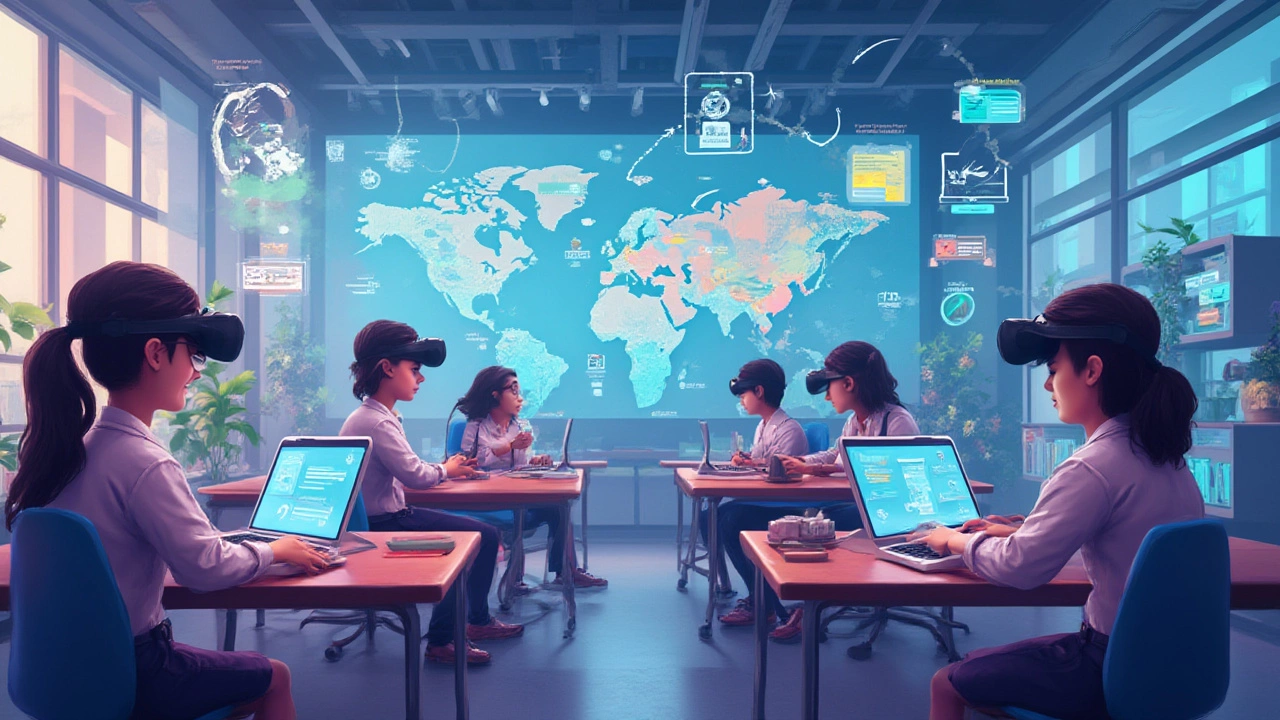Is E-Learning Just an App? Unpacking E-Learning Tools and Platforms
 Jul, 10 2025
Jul, 10 2025
Forty years ago, learning outside the classroom meant rifling through library books or mailing in your test answers. Now, you can complete a coding bootcamp, learn French, or even earn a degree without leaving your bedroom. But here's a question you might've heard at least once: Is e-learning simply an app? If you treat e-learning as just another icon next to Instagram and WhatsApp, you’ll miss the bigger picture. Let’s crack open the reasons why e-learning can't be boxed in as just an “app”—and what it really offers.
What Is E-Learning Really?
When you say 'e-learning,' do you picture Duolingo’s quirky owl, a Khan Academy video, or maybe a Zoom class during lockdown? That’s most people. E-learning, though, is much wider. At its core, it’s any learning experience delivered through digital technology—on your phone, laptop, tablet, or any device that gets you online.
Here’s a kicker: the first e-learning was over 60 years ago. In 1960, the PLATO system from the University of Illinois was teaching students on a computer mainframe. Fast forward, and you’ve got Learning Management Systems (LMS) like Moodle and Blackboard, YouTube lectures, interactive quizzes, self-paced courses, and even virtual reality classrooms. It’s a vast playground, not a single swing set.
E-learning might show up as an app—like Coursera, Udemy, or BYJU’S—or as a website, a custom enterprise platform, or a video chat. It can mean live classes, pre-recorded videos, gamified lessons, or text guides. Saying it’s just an app is like calling university 'just a building.' Both are built around experiences, communities, and ideas, not just bricks or code.
Some people love the convenience of mobile apps, since you can sneak in a quick history lesson on the bus or revise chemistry while waiting for food. But others prefer desktop experiences, with space to type or interactive diagrams. And for specialized fields, think coding or design, you’ll find platforms that need more horsepower than your mobile can handle.
A 2023 report from HolonIQ said over 1.6 billion learners engage with digital learning in some form worldwide. That’s bigger than the population of China. Apps play a huge role, but e-learning covers a lot more—classroom management systems for schools, corporate training dashboards, language labs, test prep portals, and virtual internships.
So next time someone shrugs off e-learning as “just an app,” remember: there's a whole universe crammed behind that icon.
Types of E-Learning: Beyond the App Store
Alright, let’s get into the nuts and bolts. What kinds of e-learning are people using in 2025? There’s a whole menu, way beyond what apps offer. Here’s a snapshot:
- Asynchronous Learning: This is self-paced stuff—watching videos, reading digital textbooks, taking quizzes when it suits you. No schedules, no pressure.
- Synchronous Learning: Think Zoom classes, live webinars, and interactive discussions in real time. Here, you join sessions with teachers and classmates, much like a physical class.
- Blended Learning: Schools and colleges love this. It mixes traditional teaching with digital lessons—sometimes classroom, sometimes online.
- Gamified and Simulation-Based Learning: Here, you learn by playing educational games or running simulations, like medical students practicing surgeries virtually or pilots in flight simulators.
- Social and Collaborative E-Learning: This brings students together on forums, group chats, or project boards—brainstorming, debating, and working as a team.
Each of these can exist as a standalone app, sure—but most are powered by web platforms or desktop software that packs in more features. And plenty of schools or workplaces blend several types together, creating custom solutions with apps, web sessions, and interactive platforms all rolled into one.
The lines between apps and web-based learning blur more every year. About 58% of all e-learning users prefer mobile, according to Statista, but when it comes to things like programming, design, or data analysis, web and desktop still take the cake.
Then there’s the rise of XR (extended reality) learning. In places like the University of Glasgow, engineering students build bridges in VR. These immersive experiences need specialized hardware and platforms far beyond a simple mobile app’s reach.
Here’s a quick look at different e-learning types and the tech they use:
| E-Learning Type | Common Devices | Tools & Platforms |
|---|---|---|
| Language Learning | Mobile, Web, Tablet | Duolingo, Rosetta Stone, Babbel |
| Live Classes | Web, Tablet, Desktop | Zoom, Google Meet, Microsoft Teams |
| MOOCs (Courses) | Web, Mobile, Smart TV | Coursera, edX, Udemy |
| Simulations/VR | VR Headset, Desktop | Labster, VR Classroom |
| Test Prep | Mobile, Web | BYJU’S, Unacademy, Magoosh |

Why E-Learning Isn’t Just Another App
Here’s the thing: an app makes learning accessible, but it doesn’t define it. E-learning has broad goals—think knowledge, skills, community, mentorship, assessment, and progress tracking. An app is only the delivery guy.
Take online universities: you might use an app to attend a discussion, watch lectures on a browser, submit assignments via a school portal, and track grades in a dashboard. All these tools work together, creating a complete ecosystem. The learning comes from this mix—not from any one app alone.
Now, consider how teachers personalize learning. Most e-learning platforms use smart analytics. They spot your strengths and weaknesses, offer targeted quizzes, and even suggest peer study groups—no app can do all that alone. It takes networked platforms (and sometimes artificial intelligence) humming in the background.
Lots of learners need accessibility features. E-learning platforms offer subtitles, high-contrast visual modes, screen readers, and hands-free navigation. An app might cover some, but not all users’ needs.
And let’s talk content. You can’t cram a full video editing course or virtual biology lab into a regular app. Sure, you can quiz yourself or watch quick tips, but deep, interactive learning often needs the power of web or desktop platforms, massive bandwidth, and even special hardware.
On the other side, e-learning apps are brilliant for daily streaks, social learning, and micro-courses. They hook you with notifications, badges, or friendly competition—think Duolingo’s streak reminders or Kahoot’s class quizzes. But when it’s time for formal degrees, certifications, teamwork across continents, or complex assessments, people rely on robust, platform-based systems, not just apps.
The psychology of e-learning is changing too. Stanford University’s 2024 study found students using multi-device, blended e-learning platforms scored 18% higher on retention than those limited to mobile apps. It’s about layered exposure: videos here, quizzes there, forums somewhere else—woven together for deeper learning.
So, is e-learning an app? Not quite. It’s more like an operating system for education, with apps as its features—not its definition.
Choosing the Right E-Learning Platform: Tips for Learners
Staring at the endless options in your app store or on Google can feel overwhelming. So how do you actually choose the right e-learning setup for your goals? Start with understanding your needs. Are you prepping for a competitive exam, learning a language, brushing up for work, or taking an accredited degree?
First, check for content quality. Does the platform offer resources from recognized institutions or experts? Watch for platforms working with universities or respected publishers. Next, look for flexibility. Can you access it on different devices if your phone dies or your laptop crashes? That’s handy for continuing your progress anywhere.
Does it track your progress and offer feedback? Smart apps and web platforms use analytics to show you what you’re nailing and where you’re slipping. Some platforms personalize lessons automatically—pretty cool if you want more efficient learning.
Pay attention to engagement tools: gamification keeps motivation high, but options for group discussions or peer reviews can give you a sense of community (even if you’re working in your pyjamas at home). If you need live feedback or teacher interaction, look for platforms that offer mentoring, live office hours, or discussion boards.
Accessibility is non-negotiable now. Does the platform support subtitles, screen readers, or audio learning? Check these features if you have specific needs. Also, review privacy policies and pricing. Free trials are great, but don’t get trapped in expensive subscriptions you barely use.
For those focusing on exam prep (JEE, NEET, etc.), platforms like BYJU’S and Unacademy remain favorites in India for deep competitive exam content, analytics, and mock tests. For skill upgrades—think coding or design—sites like Udemy, Coursera, and LinkedIn Learning cater to both beginners and pros, with industry-certified material.
A pro tip? Mix and match. Use quick app-based learning for daily habits but dive into web platforms for serious, in-depth study sessions. Set clear goals and build a study routine that fits your real life. If the platform has a thriving community, jump in—some of the best learning happens in discussion, not just solo study.

The Future of E-Learning: Where Do Apps Fit Now?
E-learning is evolving faster than supermarkets switch snack brands. With AI-powered tutors, VR classrooms, and adaptive content, it’s not just about sticking to one device or app anymore. Apps remain your pocket access point—perfect for on-the-go quizzes, flashcards, or language drills. But for immersive projects, team-based tasks, or jobs that need real lab simulations, you’ll still end up on platforms a single app just can’t handle.
By 2025, industry researchers like MarketsandMarkets project the global e-learning market will top $500 billion. That kind of growth spawns specialized platforms for every subject, skill, or interest you can name. Even major universities are experimenting with micro-credentials and stackable courses—sometimes app-based, often spread across web platforms and live sessions.
Apps are morphing into gateways for bigger platforms, syncing your progress everywhere—watch a video on your phone, finish an assignment on your laptop, catch up on a forum via tablet. The real trend? Seamlessness. Learning follows you, not the other way around.
So, while mobile apps are a big slice of the pie, don’t see them as the whole recipe. The future belongs to integrated learning systems—adapting to your life, preferences, schedule, and even your location. E-learning isn’t an app; it’s a brave new way to keep growing, no matter where you find yourself in the world—or what device happens to be in your hand.